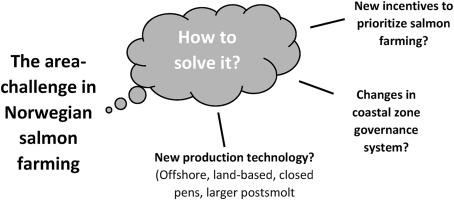当前位置:
X-MOL 学术
›
Ocean Coast Manage.
›
论文详情
Our official English website, www.x-mol.net, welcomes your feedback! (Note: you will need to create a separate account there.)
What's the clue; better planning, new technology or just more money? - The area challenge in Norwegian salmon farming
Ocean & Coastal Management ( IF 4.6 ) Pub Date : 2021-01-01 , DOI: 10.1016/j.ocecoaman.2020.105415 Bjørn Hersoug , Eirik Mikkelsen , Tonje C. Osmundsen
Ocean & Coastal Management ( IF 4.6 ) Pub Date : 2021-01-01 , DOI: 10.1016/j.ocecoaman.2020.105415 Bjørn Hersoug , Eirik Mikkelsen , Tonje C. Osmundsen

|
Abstract Norwegian salmon farming has grown tremendously over the last 50 years, and it now constitutes around 75% of the country's total seafood export value. The grow-out phase typically takes place in coastal waters. There are ambitions for continued strong growth. Five years ago, a survey revealed that the fish farmers saw the lack of available sea area as the industry's greatest challenge for continued growth. This paper examines the current and future situation for area use, needs and availability, for salmon farming in Norway. The paper considers several possible changes that can influence this, including the coastal zone planning system, new technologies for offshore, land-based and closed salmon farming, and new tax-schemes that affect the distribution of burdens and benefits from salmon farming. The main finding is that central government has several options available, if it would like to prioritise aquaculture in terms of access to coastal waters. However, this would imply a full-scale overhaul of the present allocation system, as well as a dramatic change of the current planning system, which in turn means challenging local democracy – not a very likely development under the current political circumstances. This leaves the industry with two options; to reduce salmon lice, emissions and escapes and to increase legitimacy on all levels, and by granting the local municipalities a larger share of the enormous value creation seen in the salmon sector. While the ambitious plans of doubling production by 2030 and increase it five times by 2050 certainly will require more and better coastal aquaculture localities, the actual extent of area shortage will to a large degree depend on the development of new production models; land-based, offshore, contained net pens and the production of large smolt. Success in these endeavours, could also have an impact on global production of salmon, by opening the market for new actors, thus reducing the Norwegian share and the profitability of the industry.
中文翻译:

有什么线索吗?更好的规划、新技术还是更多的钱?- 挪威鲑鱼养殖的区域挑战
摘要 挪威三文鱼养殖在过去 50 年中发展迅猛,目前占该国海产品出口总值的 75% 左右。养成阶段通常发生在沿海水域。有继续强劲增长的雄心。五年前,一项调查显示,养鱼户认为缺乏可用海域是该行业持续增长的最大挑战。本文研究了挪威鲑鱼养殖的区域使用、需求和可用性的当前和未来情况。本文考虑了可能影响这一点的几个可能的变化,包括沿海地区规划系统、近海、陆基和封闭式鲑鱼养殖的新技术,以及影响鲑鱼养殖负担和收益分配的新税收计划。主要发现是,如果中央政府希望在进入沿海水域方面优先考虑水产养殖,中央政府有多种选择。然而,这意味着对现行分配制度的全面改革,以及现行规划制度的巨大变化,这反过来又意味着挑战地方民主——在当前政治环境下不太可能发生。这给行业留下了两种选择;减少鲑鱼虱子、排放物和逃逸,并提高各级的合法性,并通过授予当地市政当局更大份额的鲑鱼行业创造的巨大价值。虽然到 2030 年产量翻番并到 2050 年增加五倍的雄心勃勃的计划肯定需要更多更好的沿海水产养殖场所,面积短缺的实际程度在很大程度上取决于新生产模式的发展;陆上的、海上的、包含网栏和大黑鲈的生产。这些努力的成功还可能对全球鲑鱼生产产生影响,为新参与者打开市场,从而降低挪威的份额和该行业的盈利能力。
更新日期:2021-01-01
中文翻译:

有什么线索吗?更好的规划、新技术还是更多的钱?- 挪威鲑鱼养殖的区域挑战
摘要 挪威三文鱼养殖在过去 50 年中发展迅猛,目前占该国海产品出口总值的 75% 左右。养成阶段通常发生在沿海水域。有继续强劲增长的雄心。五年前,一项调查显示,养鱼户认为缺乏可用海域是该行业持续增长的最大挑战。本文研究了挪威鲑鱼养殖的区域使用、需求和可用性的当前和未来情况。本文考虑了可能影响这一点的几个可能的变化,包括沿海地区规划系统、近海、陆基和封闭式鲑鱼养殖的新技术,以及影响鲑鱼养殖负担和收益分配的新税收计划。主要发现是,如果中央政府希望在进入沿海水域方面优先考虑水产养殖,中央政府有多种选择。然而,这意味着对现行分配制度的全面改革,以及现行规划制度的巨大变化,这反过来又意味着挑战地方民主——在当前政治环境下不太可能发生。这给行业留下了两种选择;减少鲑鱼虱子、排放物和逃逸,并提高各级的合法性,并通过授予当地市政当局更大份额的鲑鱼行业创造的巨大价值。虽然到 2030 年产量翻番并到 2050 年增加五倍的雄心勃勃的计划肯定需要更多更好的沿海水产养殖场所,面积短缺的实际程度在很大程度上取决于新生产模式的发展;陆上的、海上的、包含网栏和大黑鲈的生产。这些努力的成功还可能对全球鲑鱼生产产生影响,为新参与者打开市场,从而降低挪威的份额和该行业的盈利能力。



























 京公网安备 11010802027423号
京公网安备 11010802027423号